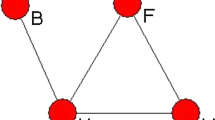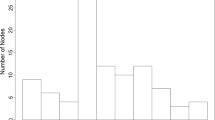Abstract
Contraction procedure of the complex chemical models with several independent intermediates by the stoichiometric network analysis, as the very useful method for such purposes, is demonstrated on the model for the hydrogen peroxide decomposition in the presence of iodate and hydrogen ions. It is shown that after reduction the model preserve main characteristics of the initial one.
Access this chapter
Tax calculation will be finalised at checkout
Purchases are for personal use only
Preview
Unable to display preview. Download preview PDF.
Similar content being viewed by others
References
B.L. Clarke, Stability of complex reaction networks, in Advances in Chemical Physics, Vol XLIII, p. l, I. Prigogine and S.A Rice, eds., J. Wiley, New York (1980).
B.L. Clarke, General method for simplifying chemical networks while preserving stoichiometry in reduced mechanisms, J.Chem. Phys., 97:4066 (1992).
W.C. Bray, A periodic reaction in homogeneous solution and its relation to catalysis, JAm.Chem.Soc., 43:1262 (1921).
W.C. Bray and H. A.Liebhafsky, Reactions involving hydrogen peroxide, iodine and iodate ion. 1. Introduction, J Am.Chem.Soc., 53:38 (1931).
Lj. Kolar-Anid, Dj. Mišljenović, S. Anic and G. Nicolis, Influence of the reduction of iodate ion by hydrogen peroxide on the model of the Bray-Liebhafsky reaction, React.Kinet.Catal.Lett., 54: 35 (1995).
G. Schmitz, Cinetigue de la reaction de Bray, J.Chim.Phys., 84:957 (1987).
Lj. Kolar-Anić and G. Schmitz, Mechanism of the Bray-Liebhafsky reaction: Effect of the oxidation of iodous acid by hydrogen peroxide, J.Chem.Soc.Faraday Trans, 88:2343 (1992).
Lj. Kolar-Anić, Dj. Mišljenović, D. Stanisavljev and S. Anić, Applicability of Schmitz’s model to dilutionreiniated oscillations in the Bray-Liebhafsky reaction, J.Phys.Chem., 94:8144 (1990).
Lj. Kolar-Anić, Ž. Čupić, S. Anić and G. Schmitz, Pseudo-steady states in the model of the Bray-Liebhafsky oscillatory reaction, JChem.Soc.FaradayTrans. 93:2147 (1997).
M. Radenkovic, G. Schmitz and Lj. Kolar-Anić, Simulation of iodine oxidation by hydrogen peroxide in acid media, on the basis of the model of Bray-Liebhafsky reaction, J.Serb. Chem.Soc., 62: 367 (1997).
Ž. Čupid and Lj. Kolar-Anić, Contraction of the model for the Bray-Liebhafsky oscillatory reaction by eliminating intermediate I2O, submitted for publication.
M.G. Peard, C.F. Cullis, A periodic chemical reaction. The reaction between hydrogen peroxide and iodic acid, Trans.Faraday Soc. 47: 616 (1951).
H. Degn, Evidence of a branched chain reaction in the oscilating reaction of hydrogen peroxide, iodine and iodate, Acta Chem.Scand. 21:1057 (1967).
K.R. Sharma, R.M. Noyes, Oscillations in chemical systems. 13. A detailed molecular mechanism for the Bray-Liebhafsky reaction of iodate and hydrogen peroxide, J.Am.Chem.Soc., 98:4345 (1976).
S. Anić, Lj. Kolar-Anić, The oscillatory decomposition of H2O2 monitored by the potentiometric method with Pt and Ag+/S2- indicator electrode, Ber. Bunsenges. Phys. Chem. 90:1084 (1986), 91: 1010 (1987).
S. Anić, Lj. Kolar-Anić, The influence of potatium iodate on hydrogen peroxide decomposition in Bray-Liebhafsky reaction, Ber.Bunsenges.Phys.Chem. 90:1084 (1986), 91:1010 (1987).
S. Anić, Lj. Kolar-Anić, Kinetic aspects of the Bray-Liebhafsky oscillatory reaction, JChem.Soc.Faraday Trans.I 84:3413 (1988).
S. Anić, D. Mitić, The Bray-Liebhafsky reaction. IV. New results in the studies of hydrogen peroxide oscillatory decomposition at high acidity, JSerb.Chem.Soc. 53:371 (1988).
S. Anić, D. Stanisavljev, Ž. Čupić, M. Radenković, V. Vukojević, Lj. Kolar-Anić, The selforganization phenomena during catalytic decomposition of hydrogen peroxide, Science of Sintering, 30:49 (1998).
Author information
Authors and Affiliations
Editor information
Editors and Affiliations
Rights and permissions
Copyright information
© 1999 Springer Science+Business Media New York
About this chapter
Cite this chapter
Čupić, Ž., Kolar-Anić, L. (1999). Contraction of the Complex Models by the Stoichiometric Network Analysis. In: Stojanović, B.D., Skorokhod, V.V., Nikolić, M.V. (eds) Advanced Science and Technology of Sintering. Springer, Boston, MA. https://doi.org/10.1007/978-1-4419-8666-5_8
Download citation
DOI: https://doi.org/10.1007/978-1-4419-8666-5_8
Publisher Name: Springer, Boston, MA
Print ISBN: 978-1-4613-4661-6
Online ISBN: 978-1-4419-8666-5
eBook Packages: Springer Book Archive




